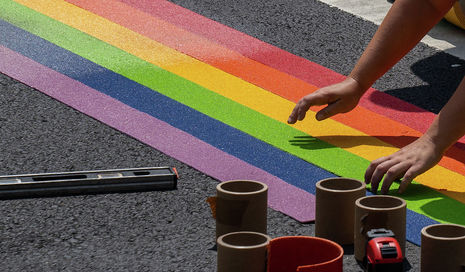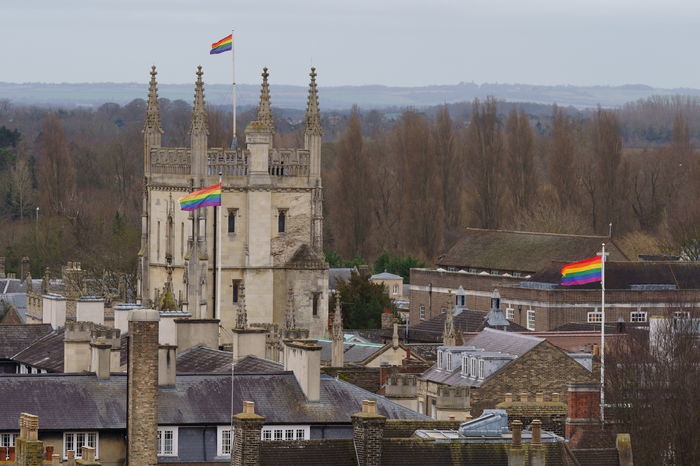Putting a price on pride: the dilemma of rainbow capitalism
Benny Soran argues that, as Pride month comes to an end, we must reconsider how brands align themselves with the cause beyond simply adopting a rainbow aesthetic.

Pride has always meant celebrating the colourful and dynamic identities of those that make up the queer community. Having started as a protest by black trans women, Pride’s main objective has always been to rebel against the systemic injustices that have resulted in the continued marginalisation of and discrimination against those in the LGBTQIA+ community. However, as queerness has become more ‘socially acceptable,’ what was once a protest has now become a gaudy display of commercialisation. Everywhere you look, be it cafés, restaurants, or shops, products once coated with monotone whites and blacks have been dramatically repainted with rainbows, supposedly to show these corporations’ attempts at solidarity and allyship.
Welcome to Pride month – an extravaganza of all things queer! During February, every brand seems to be getting in on what has become the normative way of marketing and advertising their brands. Rainbow mouthwash? Hygienic and accepting! Rainbow water bottles? Hydrating and fabulous! Don’t get me wrong, I like rainbow apparel as much as the next person. Who doesn’t feel a little bit better with rainbow-streaked storefronts brightening up the dull dreariness that is the British winter? Even more importantly, surely it’s a good thing that a closeted teen can walk into a store and see their identity represented in a mainstream, visible space – right?
Well, perhaps. For those who come from homophobic backgrounds and whose parents do not understand their being gay, a TV ad might be the catalyst that leads their parents to accepting them for who they are. Other people, however, see these initiatives as indicative of corporations co-opting Pride to sell products, ticking boxes for demographic outreach programmes at the same time.
“Companies have launched campaigns that seem little more than attempts to hop on the now trendy bandwagon while increasing their profits.”
While Pride has become a celebrated, capitalist spectacle shining bright with rainbow sheens, this heavily monetised sales period represents the ostensibly well-intended attempts of large corporations to channel the joy and celebration of those that they are both tokenising and making money from. While allies are certainly well-appreciated, the question must be asked: do the mass displays of rainbows actually do anything to further equality, or are the vapid showcases of rainbow coffee mugs and emblazoned t-shirts simply there to increase profits for companies during a now-lucrative sales period?
As queer people have become more publicly recognised as people with power to help shape the economy (the pink pound, anyone?), companies have launched campaigns that seem little more than attempts to hop on the now trendy bandwagon while increasing their profits. In 2019, for example, fast fashion brand Boohoo created the #LoveWithoutLimits campaign which featured various rainbow t-shirts, sequin skirts, and more. The company contributed merely 10% of the profits to LGBTQIA+ charities, showing how the campaign served as nothing more than a marketing tactic masquerading itself as activism. This example shows the ways in which brands capitalising on queerness have used Pride month allyship to profit from a marginalised community.
Additionally, many companies that launch Pride campaigns work with notoriously anti-LGBTQIA+ organisations and people. It has been reported in the US that former Senator Rick Santorum, who has been vehemently homophobic, received thousands of dollars of political donations from the CEO of Urban Outfitters. Urban Outfitters celebrates Pride annually and has even partnered with GLSEN in support of LGBTQIA+ youth. This demonstrates how there exists an uncomfortable duality to the LGBTQIA+ activism work of corporations.
“For brands to actually be good allies, allyship must extend beyond Pride month and be incorporated into every aspect of their business model.”
So, is it possible for rainbow capitalism to actually do good, or is it just another case study in shallow performativity? The answer lies in the inherent limitations of Pride month as a barometer for brands’ allyship. Organisations only deem it necessary to be good allies for the month – once the 28th of February rolls around, they pack up their rainbow products and end their Pride campaigns. For brands to actually be good allies, allyship must extend beyond Pride month and be incorporated into their business model. This might include hiring queer employees, partnering with reputable queer organisations, and actually making sizeable donations to LGBTQIA+ charities. Large corporations have the ability and platform to shift power structures and transform the landscape in which they operate.
Previous popular conceptualisations of queer justice have been closely tied to heteronormative, capitalist modes of thinking, mainly limited to gay rights and gay marriage. While certainly important, reducing queer history into palatable, colourful commodities ignores its vast history and the inextricable link between queer justice and issues such as colonialism, transphobia, housing discrimination, and many others. These injustices cannot be solely blamed on large corporations. But such corporations have the resources available to help those who have been previously marginalised through various initiatives: partnerships with queer-led organisations and extensive diversity and equality training, for example.
While there is still much work to be done, there are organisations that have implemented concrete campaigns to help the LGBTQIA+ community. ASOS has partnered with GLAAD on a 50-piece collection with 100% of net proceeds going to the organisation. Nordstrom is donating 100% of proceeds from a t-shirt that benefits the Human Rights Campaign and is sponsoring several pride parades in the US and Canada. Rather than tokenising the queer demographic, these attempts have shown the extent to which it is possible for brands to help those in vulnerable communities, while moving beyond the corporate act of product creation and brand curation.
We all love a colourful aesthetic, but drinking your oat milk latte out of a rainbow Costa cup does not make you a good ally. Celebrating Pride means much more than purchasing colourful merchandise. So, before spending your pounds on rainbow goods, consider the above issues. It is ultimately up to consumers to hold brands accountable and ensure they create inclusive environments every month of the year, long after the rainbow storefront facades stores have been dismantled and the celebrations of Pride month have ended.
 News / Cambridge academics stand out in King’s 2026 Honours List2 January 2026
News / Cambridge academics stand out in King’s 2026 Honours List2 January 2026 Comment / Plastic pubs: the problem with Cambridge alehouses 5 January 2026
Comment / Plastic pubs: the problem with Cambridge alehouses 5 January 2026 News / Cambridge businesses concerned infrastructure delays will hurt growth5 January 2026
News / Cambridge businesses concerned infrastructure delays will hurt growth5 January 2026 News / AstraZeneca sues for £32 million over faulty construction at Cambridge Campus31 December 2025
News / AstraZeneca sues for £32 million over faulty construction at Cambridge Campus31 December 2025 Interviews / You don’t need to peak at Cambridge, says Robin Harding31 December 2025
Interviews / You don’t need to peak at Cambridge, says Robin Harding31 December 2025









